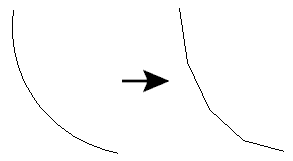Converts arc features into lines replacing the feature geometry with a series of edges interpolated along the arc boundary. Ellipse features are converted into polygons by interpolating edges along the elliptical boundary.
If the input geometry is a path consisting of arcs and lines, or an area whose boundary is such a path, then any arcs in the path will be stroked, also using the Number of Interpolated Edges given.
Example

Configuration
Input Ports
This transformer accepts features with arc or ellipse geometry. Other features are unchanged.
Output Ports
All point, line, and area features are output through this port.
All features that are not points, lines, or areas are output through this port.
Parameters
|
Stroke By |
You can convert arc or ellipse features into lines either by specifying the Number of Interpolated Edges or the Maximum Deviation. The Number of Interpolated Edges and the Maximum Deviation may either be entered as a number, or can be taken from the value of a feature attribute by selecting the attribute name from the pull-down list. |
|
Number of Interpolated Edges |
If this parameter is specified and set to 0, then a reasonable number of edges will be interpolated for the arc. |
|
Maximum Deviation |
If the Maximum Deviation is specified and has a value greater than 0, then arcs are converted into lines such that the maximum distance between the lines and the arcs is not greater than the value specified. If the Maximum Deviation value is greater than the primary or secondary axis of the arc or ellipse, then the converted lines will have minimum number of edges possible. If the Maximum Deviation value is smaller than or equal to 0, then the value of the Stroke Maximum Deviation advanced setting set in the workspace is used. If both values are smaller than or equal to 0, then arcs are converted into lines using the Number of Interpolated Edges value of 0. |
|
Make Polygon Out of 360 Degree Arcs |
If this parameter is set to Yes, then arc features with a 360-degree sweep angle are converted into polygons. Otherwise, they are converted into lines. |
Editing Transformer Parameters
Using a set of menu options, transformer parameters can be assigned by referencing other elements in the workspace. More advanced functions, such as an advanced editor and an arithmetic editor, are also available in some transformers. To access a menu of these options, click  beside the applicable parameter. For more information, see Transformer Parameter Menu Options.
beside the applicable parameter. For more information, see Transformer Parameter Menu Options.
Defining Values
There are several ways to define a value for use in a Transformer. The simplest is to simply type in a value or string, which can include functions of various types such as attribute references, math and string functions, and workspace parameters. There are a number of tools and shortcuts that can assist in constructing values, generally available from the drop-down context menu adjacent to the value field.
Using the Text Editor
The Text Editor provides a convenient way to construct text strings (including regular expressions) from various data sources, such as attributes, parameters, and constants, where the result is used directly inside a parameter.
Using the Arithmetic Editor
The Arithmetic Editor provides a convenient way to construct math expressions from various data sources, such as attributes, parameters, and feature functions, where the result is used directly inside a parameter.
Conditional Values
Set values depending on one or more test conditions that either pass or fail.
Parameter Condition Definition Dialog
Content
Expressions and strings can include a number of functions, characters, parameters, and more.
When setting values - whether entered directly in a parameter or constructed using one of the editors - strings and expressions containing String, Math, Date/Time or FME Feature Functions will have those functions evaluated. Therefore, the names of these functions (in the form @<function_name>) should not be used as literal string values.
| These functions manipulate and format strings. | |
|
Special Characters |
A set of control characters is available in the Text Editor. |
| Math functions are available in both editors. | |
| Date/Time Functions | Date and time functions are available in the Text Editor. |
| These operators are available in the Arithmetic Editor. | |
| These return primarily feature-specific values. | |
| FME and workspace-specific parameters may be used. | |
| Creating and Modifying User Parameters | Create your own editable parameters. |
Dialog Options - Tables
Transformers with table-style parameters have additional tools for populating and manipulating values.
|
Row Reordering
|
Enabled once you have clicked on a row item. Choices include:
|
|
Cut, Copy, and Paste
|
Enabled once you have clicked on a row item. Choices include:
Cut, copy, and paste may be used within a transformer, or between transformers. |
|
Filter
|
Start typing a string, and the matrix will only display rows matching those characters. Searches all columns. This only affects the display of attributes within the transformer - it does not alter which attributes are output. |
|
Import
|
Import populates the table with a set of new attributes read from a dataset. Specific application varies between transformers. |
|
Reset/Refresh
|
Generally resets the table to its initial state, and may provide additional options to remove invalid entries. Behavior varies between transformers. |
Note: Not all tools are available in all transformers.
FME Community
The FME Community is the place for demos, how-tos, articles, FAQs, and more. Get answers to your questions, learn from other users, and suggest, vote, and comment on new features.
Search for all results about the ArcStroker on the FME Community.




